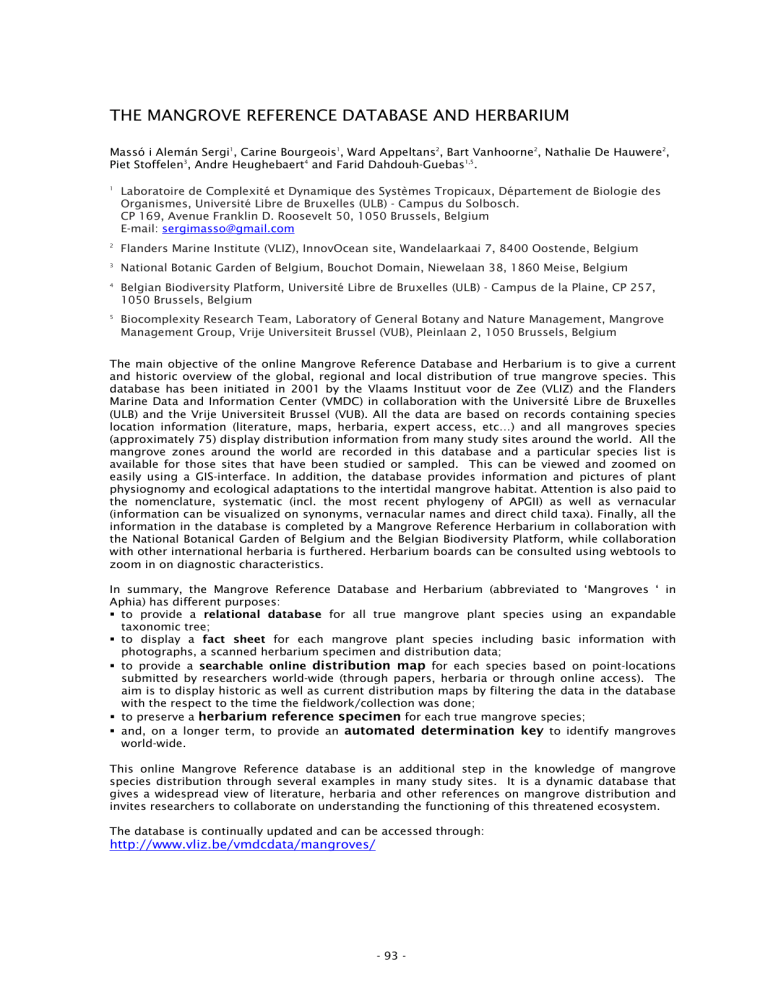
THE MANGROVE REFERENCE DATABASE AND HERBARIUM
Massó i Alemán Sergi1, Carine Bourgeois1, Ward Appeltans2, Bart Vanhoorne2, Nathalie De Hauwere2,
Piet Stoffelen3, Andre Heughebaert4 and Farid Dahdouh-Guebas1,5.
1
Laboratoire de Complexité et Dynamique des Systèmes Tropicaux, Département de Biologie des
Organismes, Université Libre de Bruxelles (ULB) - Campus du Solbosch.
CP 169, Avenue Franklin D. Roosevelt 50, 1050 Brussels, Belgium
E-mail: [email protected]
2
Flanders Marine Institute (VLIZ), InnovOcean site, Wandelaarkaai 7, 8400 Oostende, Belgium
3
National Botanic Garden of Belgium, Bouchot Domain, Niewelaan 38, 1860 Meise, Belgium
4
Belgian Biodiversity Platform, Université Libre de Bruxelles (ULB) - Campus de la Plaine, CP 257,
1050 Brussels, Belgium
5
Biocomplexity Research Team, Laboratory of General Botany and Nature Management, Mangrove
Management Group, Vrije Universiteit Brussel (VUB), Pleinlaan 2, 1050 Brussels, Belgium
The main objective of the online Mangrove Reference Database and Herbarium is to give a current
and historic overview of the global, regional and local distribution of true mangrove species. This
database has been initiated in 2001 by the Vlaams Instituut voor de Zee (VLIZ) and the Flanders
Marine Data and Information Center (VMDC) in collaboration with the Université Libre de Bruxelles
(ULB) and the Vrije Universiteit Brussel (VUB). All the data are based on records containing species
location information (literature, maps, herbaria, expert access, etc…) and all mangroves species
(approximately 75) display distribution information from many study sites around the world. All the
mangrove zones around the world are recorded in this database and a particular species list is
available for those sites that have been studied or sampled. This can be viewed and zoomed on
easily using a GIS-interface. In addition, the database provides information and pictures of plant
physiognomy and ecological adaptations to the intertidal mangrove habitat. Attention is also paid to
the nomenclature, systematic (incl. the most recent phylogeny of APGII) as well as vernacular
(information can be visualized on synonyms, vernacular names and direct child taxa). Finally, all the
information in the database is completed by a Mangrove Reference Herbarium in collaboration with
the National Botanical Garden of Belgium and the Belgian Biodiversity Platform, while collaboration
with other international herbaria is furthered. Herbarium boards can be consulted using webtools to
zoom in on diagnostic characteristics.
In summary, the Mangrove Reference Database and Herbarium (abbreviated to ‘Mangroves ‘ in
Aphia) has different purposes:
to provide a relational database for all true mangrove plant species using an expandable
taxonomic tree;
to display a fact sheet for each mangrove plant species including basic information with
photographs, a scanned herbarium specimen and distribution data;
to provide a searchable online distribution map for each species based on point-locations
submitted by researchers world-wide (through papers, herbaria or through online access). The
aim is to display historic as well as current distribution maps by filtering the data in the database
with the respect to the time the fieldwork/collection was done;
to preserve a herbarium reference specimen for each true mangrove species;
and, on a longer term, to provide an automated determination key to identify mangroves
world-wide.
This online Mangrove Reference database is an additional step in the knowledge of mangrove
species distribution through several examples in many study sites. It is a dynamic database that
gives a widespread view of literature, herbaria and other references on mangrove distribution and
invites researchers to collaborate on understanding the functioning of this threatened ecosystem.
The database is continually updated and can be accessed through:
http://www.vliz.be/vmdcdata/mangroves/
- 93 -






